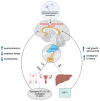Genetic and Epigenetic Sexual Dimorphism of Brain Cells during Aging
- PMID: 36831738
- PMCID: PMC9954625
- DOI: 10.3390/brainsci13020195
Genetic and Epigenetic Sexual Dimorphism of Brain Cells during Aging
Abstract
In recent years, much of the attention paid to theoretical and applied biomedicine, as well as neurobiology, has been drawn to various aspects of sexual dimorphism due to the differences that male and female brain cells demonstrate during aging: (a) a dimorphic pattern of response to therapy for neurodegenerative disorders, (b) different age of onset and different degrees of the prevalence of such disorders, and (c) differences in their symptomatic manifestations in men and women. The purpose of this review is to outline the genetic and epigenetic differences in brain cells during aging in males and females. As a result, we hereby show that the presence of brain aging patterns in males and females is due to a complex of factors associated with the effects of sex chromosomes, which subsequently entails a change in signal cascades in somatic cells.
Keywords: aging; brain; epigenetic; genetic; sexual dimorphism.
Conflict of interest statement
The authors declare no conflict of interest. The funders had no role in the design of the study; in the collection, analyses, or interpretation of data; in the writing of the manuscript; or in the decision to publish the results.
Figures




Similar articles
-
Sexual dimorphism in the vomeronasal pathway and sex differences in reproductive behaviors.Brain Res Brain Res Rev. 1993 Jan-Apr;18(1):51-74. doi: 10.1016/0165-0173(93)90007-m. Brain Res Brain Res Rev. 1993. PMID: 8467350 Review.
-
Insights into the genetic architecture of sexual dimorphism from an interspecific cross between two diverging Silene (Caryophyllaceae) species.Mol Ecol. 2019 Dec;28(23):5052-5067. doi: 10.1111/mec.15271. Epub 2019 Nov 5. Mol Ecol. 2019. PMID: 31605646
-
Ontogeny of sexual size dimorphism in monitor lizards: males grow for a longer period, but not at a faster rate.Zoolog Sci. 2010 Dec;27(12):917-23. doi: 10.2108/zsj.27.917. Zoolog Sci. 2010. PMID: 21110717
-
Sexual dimorphism of the mandibular conformational changes in aging human adults: A multislice computed tomographic study by geometric morphometrics.PLoS One. 2021 Jun 22;16(6):e0253564. doi: 10.1371/journal.pone.0253564. eCollection 2021. PLoS One. 2021. PMID: 34157047 Free PMC article.
-
Sexually dimorphic microglia and ischemic stroke.CNS Neurosci Ther. 2019 Dec;25(12):1308-1317. doi: 10.1111/cns.13267. Epub 2019 Nov 20. CNS Neurosci Ther. 2019. PMID: 31747126 Free PMC article. Review.
Cited by
-
The Anti-Elixir Triad: Non-Synced Circadian Rhythm, Gut Dysbiosis, and Telomeric Damage.Med Princ Pract. 2025;34(3):212-225. doi: 10.1159/000542557. Epub 2024 Nov 13. Med Princ Pract. 2025. PMID: 39536739 Free PMC article. Review.
-
Sex-Biased Expression and Response of microRNAs in Neurological Diseases and Neurotrauma.Int J Mol Sci. 2024 Feb 24;25(5):2648. doi: 10.3390/ijms25052648. Int J Mol Sci. 2024. PMID: 38473893 Free PMC article. Review.
-
The Spectrum of Peripheral-Vestibular Deficits and Their Change Over Time in CANVAS/RFC1-Related Ataxia Systematic Review and Meta-Analysis of Quantitative Head-Impulse Testing.Cerebellum. 2025 Mar 20;24(3):67. doi: 10.1007/s12311-025-01825-y. Cerebellum. 2025. PMID: 40111638 Free PMC article.
References
-
- Yang J., Qu J., Ma H. Recent developments in understanding brain aging: Sex differences, mechanisms, and implications in diseases. Ageing Neurodegener. Dis. 2022;2:3. doi: 10.20517/and.2022.03. - DOI
Publication types
Grants and funding
LinkOut - more resources
Full Text Sources
Research Materials

